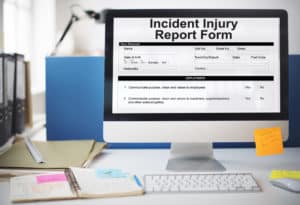
Many employers miss a golden opportunity to control the cost of their workers’ compensation claims by failing to take appropriate action to investigate a workers’ compensation claim when it is reported.
Crystal Clear Employee Report of Incident
The employee should be asked to provide a written description of what caused the accident and to offer his/her opinion on how the accident could be prevented in the future. The employee’s recall immediately after the accident is more complete and will be the more accurate then months or years later.
By having the employee document the accident details and the nature and scope of the injury, the employee is prevented from embellishing the details of the event later if he/she decides to capitalize on the injury by pressing for a higher than justified settlement of the claim. Also, by having the employee specify exactly what body parts were injured, it limits the employee’s ability to bring in additional body parts at a later time. For example – the employee fell and hurt his elbow. By having the written description of the injury from the employee, the employee cannot claim months later he/she also hurt her knee in the accident.
If the employee is manufacturing a claim, or even has a legitimate injury, the employee will be reluctant to try to expand the claim when he/she knows she has committed the details of the accident and the extent of the injury to a document that the employer has.
Witness Report of Incident
The written accident report of the employee is made more beneficial when the employer also obtains a written statement from each witness to the event. The independent witnesses are an excellent source of information about the accident, and the extent of the injury to the injured employee. Beware of the accident that has no witnesses, or only a witness who is a close friend of the employee.
The information collected from the employee and the witnesses should be reviewed by either the employee’s supervisor or someone knowledgeable about the work process to verify the information provided is accurate. The employee’s accident statement and the witness statements should be provided to the workers’ compensation adjuster, along with the First Report of Injury form.
If the employer has knowledge of a previous workers’ compensation claim, that information should also be provided to the adjuster. Any information about accidents or injuries the employee has had in the past should be shared as well. If the employee is known to participate in strenuous physical activities, sports or hobbies, that should be disclosed to the adjuster as well.
Adjuster Recorded Statement
If the adjuster has any reason to question the claim, the adjuster will often take a recorded statement from the employee. The adjuster will be particularly interested in deviation of the accident details, or the nature and scope of the injury, from what the employee provided to the employer. The adjuster in addition to inquiring about the accident details will ask the employee about any prior injury claims, any other accidents (for example – personal automobile accidents) and any prior injuries to the same body part (for example – previous back injury).
Properly Investigate All Accidents
The majority of workers’ compensation claims are valid and the employee deserves the medical care and indemnity benefits specified in the workers’ compensation statutes. The investigation of the claim identifies those claims that are questionable or fraudulent and should be resisted. The investigation also limits the ability of the employee of questionable character in exploiting the legitimate workers’ compensation claim. We strongly recommend you establish the protocol of investigating all accidents.
For additional information on workers’ compensation cost containment best practices, register as a guest for our next live stream training.

Contact: mstack@reduceyourworkerscomp.com.
Workers’ Comp Roundup Blog: https://blog.reduceyourworkerscomp.com/
Live Stream WC Training: http://workerscompclub.com/livestreamtraining
©2017 Amaxx LLC. All rights reserved under International Copyright Law.
Do not use this information without independent verification. All state laws vary. You should consult with your insurance broker, attorney, or qualified professional.















